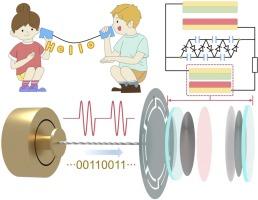当前位置:
X-MOL 学术
›
Nano Energy
›
论文详情
Our official English website, www.x-mol.net, welcomes your
feedback! (Note: you will need to create a separate account there.)
Tin can telephone-inspired self-powered mechanical wave communication integrated with self-charge excitation triboelectric nanogenerator
Nano Energy ( IF 16.8 ) Pub Date : 2024-11-13 , DOI: 10.1016/j.nanoen.2024.110470 Shanshan An, Gui Li, Xiang Zhou, Hongji Pu, Jian Wang, Yuling Cheng, Sizhao Liu, Tao Zhou, Yan Zhou, Xianjie Pu
Nano Energy ( IF 16.8 ) Pub Date : 2024-11-13 , DOI: 10.1016/j.nanoen.2024.110470 Shanshan An, Gui Li, Xiang Zhou, Hongji Pu, Jian Wang, Yuling Cheng, Sizhao Liu, Tao Zhou, Yan Zhou, Xianjie Pu

|
As an alternative to electromagnetic wave communication, mechanical waves (MW) retain their advantage in several aspects, including cost-effectiveness, simplicity, interference resistance, and short-distance transmission. Here, a string-vibrated self-powered mechanical wave communication system (SSMWC) is proposed. Inspired by tin can telephone, modulated voltage signals are converted into MW by a vibrator and then transmitted along a string to the receiver. The receiver integrates a string-vibrated triboelectric nanogenerator (SV-TENG) and a self-charge excitation triboelectric nanogenerator (SCE-TENG). The SV-TENG can detect MW and convert them into electrical signals without external power sources, while the SCE-TENG is integrated to improve the sensitivity of the receiver. After charges pumping of SCE-TENG, the average output of SV-TENG can increase by 88 times within the frequency range of 0–1000 Hz, indicating the successful application of self-charge excitation in triboelectric sensing for the first time. Furthermore, a demonstration of information coding and real-time decoding proves the potential application of SSMWC as an alternative in specific environments. This work shows the breakthrough of the bottlenecks faced by triboelectric sensors that the essential preparatory contact electrification before packaging, which indeed affect sensitivity and durability. Therefore, this scheme can be widely applied for output enhancement, especially for triboelectric sensors with lower output.
中文翻译:

一种锡罐电话式自供电机械波通信与自充电励磁摩擦纳米发电机集成
作为电磁波通信的替代方案,机械波 (MW) 在几个方面保留了其优势,包括成本效益、简单性、抗干扰性和短距离传输。本文提出了一种弦振动自供电机械波通信系统 (SSMWC)。受锡罐电话的启发,调制电压信号通过振动器转换为 MW,然后沿字符串传输到接收器。接收器集成了组串振动摩擦纳米发电机 (SV-TENG) 和自充电励磁摩擦纳米发电机 (SCE-TENG)。SV-TENG 可以检测 MW 并将其转换为电信号,而无需外部电源,而集成 SCE-TENG 以提高接收器的灵敏度。SCE-TENG 充电泵浦后,SV-TENG 的平均输出在 0–1000 Hz 的频率范围内可增加 88 倍,表明自充电激励首次成功应用于摩擦电传感。此外,信息编码和实时解码的演示证明了 SSMWC 作为特定环境中替代方案的潜在应用。这项工作揭示了摩擦电传感器面临的瓶颈的突破,即封装前必不可少的准备接触电气化,这确实影响了灵敏度和耐用性。因此,该方案可以广泛应用于输出增强,特别是对于输出较低的摩擦电传感器。
更新日期:2024-11-13
中文翻译:

一种锡罐电话式自供电机械波通信与自充电励磁摩擦纳米发电机集成
作为电磁波通信的替代方案,机械波 (MW) 在几个方面保留了其优势,包括成本效益、简单性、抗干扰性和短距离传输。本文提出了一种弦振动自供电机械波通信系统 (SSMWC)。受锡罐电话的启发,调制电压信号通过振动器转换为 MW,然后沿字符串传输到接收器。接收器集成了组串振动摩擦纳米发电机 (SV-TENG) 和自充电励磁摩擦纳米发电机 (SCE-TENG)。SV-TENG 可以检测 MW 并将其转换为电信号,而无需外部电源,而集成 SCE-TENG 以提高接收器的灵敏度。SCE-TENG 充电泵浦后,SV-TENG 的平均输出在 0–1000 Hz 的频率范围内可增加 88 倍,表明自充电激励首次成功应用于摩擦电传感。此外,信息编码和实时解码的演示证明了 SSMWC 作为特定环境中替代方案的潜在应用。这项工作揭示了摩擦电传感器面临的瓶颈的突破,即封装前必不可少的准备接触电气化,这确实影响了灵敏度和耐用性。因此,该方案可以广泛应用于输出增强,特别是对于输出较低的摩擦电传感器。


















































 京公网安备 11010802027423号
京公网安备 11010802027423号